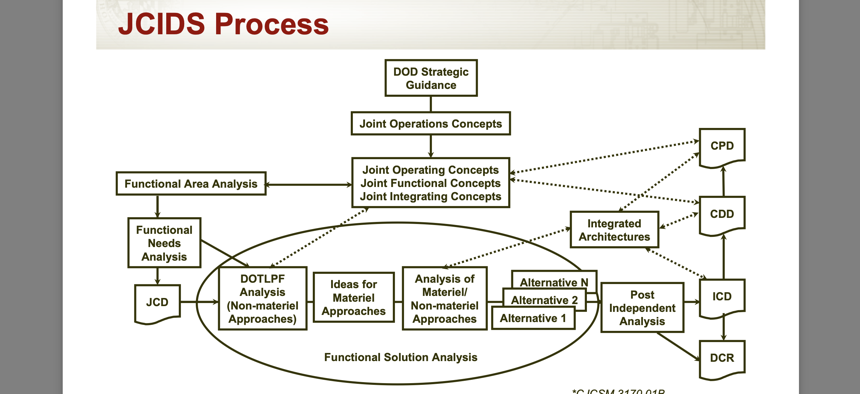Key Facts
- A 20 August memo directs the disestablishment of JCIDS, re-orienting the JROC and creating a Requirements & Resourcing Alignment Board (RRAB).
- A new Mission Engineering & Integration Activity (MEIA) will engage industry earlier and run structured experimentation campaigns.
- Funds will flow via a Joint Acceleration Reserve (JAR) aligned to ranked Key Operational Problems (KOPs).
- The shift prioritizes speed and iterative solutions—echoing REF-era “51 percent solution” practices—while raising interoperability and rigor concerns.

Why the decision to end JCIDS matters
The announcement that the Pentagon ends JCIDS marks the most consequential change to U.S. requirements governance in two decades. JCIDS—formalized in 2003 to centralize capability needs across the services—became synonymous with weighty documents, multi‑year staffing, and late-to-need capabilities. Its disestablishment signals a strategic pivot: away from procedural compliance and toward mission‑driven problem solving and time‑bound outcomes.
For allies and industrial partners—including Türkiye’s resilient defence industrial base—this is not mere inside‑baseball. A requirements regime that emphasizes Key Operational Problems (KOPs), rapid experimentation, and earlier industry engagement will change how NATO‑relevant programs are scoped, funded, and fielded. Suppliers who can demonstrate speed to field and credible integration pathways will earn disproportionate advantage.
What replaces JCIDS—and how it will work
The reform package does not create a vacuum; it installs a new operating model.
1) JROC, re‑oriented to KOPs. The Joint Requirements Oversight Council pivots from validating component documents to ranking joint KOPs derived from the National Defense Strategy and Joint Warfighting Concept. This transforms the JROC from a document gatekeeper into a strategic integrator that prioritizes problems.
2) RRAB, the budget bridge. The Requirements & Resourcing Alignment Board (RRAB)—co‑chaired by the Vice Chairman of the Joint Chiefs and the Deputy Secretary—ties analysis to resourcing each Program & Budget Review cycle. This is the linchpin that converts prioritized KOPs into programmed dollars via the Joint Acceleration Reserve (JAR).
3) MEIA, the engineering engine. A new Mission Engineering & Integration Activity (MEIA) conducts mission engineering, coordinates experimentation campaigns, and engages industry early—explicitly to generate solution options that can scale. Done well, MEIA should reduce the notorious “valley of death” between prototypes and programs of record.
4) Services reclaim validation. With Pentagon ends JCIDS as policy, services regain authority over the bulk of requirements validation and must streamline their own processes within 90 days. Expect divergence by culture and domain: e.g., the Navy’s portfolio executives vs. the Army’s rapid aviation/munitions lines.
Strategic upside—and the risks to watch
This reset addresses persistent critiques documented by GAO: rising portfolio costs, elongated schedules, and technology obsolescence at fielding. By aligning requirements, engineering and resourcing around ranked KOPs, the department can cut queuing time and focus on end‑to‑end delivery.
However, three risk vectors deserve board‑level attention:
Joint coherence. JCIDS, for all its friction, forced a joint conversation. If services run faster in parallel, who arbitrates interoperability and mission thread trades? The RRAB‑MEIA‑JROC triad must institutionalize joint design reviews, interface control, and data‑sharing to prevent stovepipe drift.
Rigor vs. speed. The REF’s famed “51 percent solution” saved lives by delivering something now and iterating. Institutionalizing that ethos is smart—but only if paired with disciplined test, cyber‑worthiness, spectrum certification, and modular open systems discipline. Speed without engineering quality merely accelerates rework.
Budget realism. A standing JAR is promising, yet withholding top‑line to feed it will trigger trade‑offs in legacy programs. Success hinges on ironclad criteria for KOP selection, credible kill‑switches for underperformers, and transparent reporting to Congress.
What it means for industry—especially NATO suppliers
For primes and SMEs alike, Pentagon ends JCIDS reshapes capture strategy around problem portfolios, not point solutions. Winning teams will:
- Anchor proposals to KOP‑aligned mission outcomes, not feature lists. “What operational gap does this close in 18 months?” becomes the opening slide.
- Offer integration‑ready architectures (open standards, interface control docs, digital twins) that MEIA can stitch into multi‑domain experiments.
- Demonstrate credible speed: TRL maturity, supplier depth, and production surge plans that withstand campaign tempo.
- Navigate security and exportability early, enabling coalition uptake for NATO allies and partners.
Türkiye’s defence‑aerospace ecosystem—now competing in 120+ countries—is well‑positioned for this problem‑centric era: agile UAV/UGV houses, mission systems integrators, SATCOM and ISR payload specialists, and software‑defined radio vendors all map cleanly to KOP‑driven campaigns.
Editorial analysis: from requirements to results
The intellectual center of gravity here is a cultural shift many innovators have urged for years: replace requirement worship with problem ownership. Notably, practitioners from the Army’s Rapid Equipping Force and the university‑to‑DoD pipeline Hacking for Defense (H4D) have shown that curated problem statements, continuous user validation, and iterative prototyping generate faster, more relevant capability.
With Pentagon ends JCIDS, the department appears to be encoding that playbook at enterprise scale. Success will require a few hard rules:
- Time‑boxed learning. MEIA campaigns should publish 90‑day learning objectives and decision gates, not endless “experiments.”
- Open architectures by default. Portfolio executives should treat MOSA as a contractually enforced baseline, tying RRAB dollars to verifiable interface compliance.
- Outcome‑based metrics. Replace document milestones with mission‑effectiveness KPIs (kill‑chain latency, sortie rate under EW stress, cross‑domain target custody, etc.).
If these disciplines stick, the reform could do more than speed paperwork; it could shorten kill‑chains and align budgets to real operational advantage.
Internal link
For a broader view of how acquisition shifts shape global defence markets, see our Strategic Trends briefing on Defence Agenda (opens in a new tab).
- [Defence & Aerospace Strategic Trends](https://defenceagenda.com/defense-and-aerospace-strategic-trends/ “Defence & Aerospace Strategic Trends”
External insight
For the primary sources and expert reporting underpinning this analysis, consult:
- Secretary of Defense memo (20 Aug 2025) directing JCIDS disestablishment and establishing RRAB/MEIA/JAR (opens in a new tab).
- Breaking Defense’s detailed memo analysis (opens in a new tab).
- GAO’s 2025 annual weapon systems assessment on cost growth and schedule slippage (opens in a new tab).
- CRS primer on JCIDS, for historical context (opens in a new tab).
- H4D program overview, illustrating problem‑centric innovation pathways (opens in a new tab).
Conclusion
Pentagon ends JCIDS is not the finish line; it is the starting gun for a performance‑driven requirements enterprise. The winners will be those who translate prioritized KOPs into integrated, testable, and fieldable capability within funding cycles—not decades. For NATO and partners, the message is clear: bring solutions that can plug into mission threads, withstand campaign pace, and prove value in weeks, not years.
References
- Defense One commentary by Peter A. Newell, RIP, JCIDS. Let’s stop writing requirements and start solving problems (25 Aug 2025). [Link](https://www.defenseone.com/ideas/2025/08/rip-jcids-lets-stop-writing-requirements-and-start-solving-problems/407675/
- Secretary of Defense & Deputy Secretary memo, Reforming the Joint Requirements Process to Accelerate Fielding of Warfighting Capabilities (20 Aug 2025). [PDF](https://www.newspacenexus.org/wp-content/uploads/2025/08/SecDef-Memo-20-Aug-2025.pdf
- Breaking Defense, Pentagon terminating JCIDS process as part of larger acquisition reform: Memo (22 Aug 2025). [Link](https://breakingdefense.com/2025/08/pentagon-terminating-jcids-process-as-part-of-larger-acquisition-reform-memo/
- GAO, Weapon Systems Annual Assessment: DOD Leaders Must Act to Address Cost Growth (11 Jun 2025). [Summary](https://www.gao.gov/products/gao-25-107569 “GAO report” target=”_blank” rel=”noopener noreferrer external” data-verified=”manual”) | [PDF](https://www.gao.gov/assets/gao-25-107569.pdf
- CRS, Defense Primer: Joint Capabilities Integration and Development System (JCIDS). [Link](https://www.congress.gov/crs-product/IF12817
- Hacking for Defense (H4D) program overview. [Link](https://www.h4d.us/










